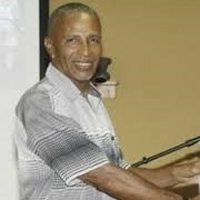media_artricles :: 2015
ArticleName
Garth Wattley :: Trinidad Express :: 21.04.2015There seems to be some life left in Marc Burns’ legs.
It was good to see that even at what one might consider the veterans stage of his career, T&T’s most senior sprinter can still finish at the head of the field as he did on the weekend in the USA.
Recent years have not been kind to him with injury, and people like Richard Thompson and Keston Bledman are now the ones expected to carry more of the load in the sprints, and especially in the relays, where T&T have had more success at big games over the last decade or so.
But T&T’s success at 4x100 level has had much to do with the presence of Burns.
On his CV, he counts three World Championships relay silver medals from the meets in Edmonton (2001), Helsinki (2005) and Berlin (2009), and Olympic silver behind the unstoppable Jamaicans in Beijing in 2008 and a bronze by virtue of a disqualification at London in 2012.
As an individual, Burns also has a 100 metres bronze medal from the 2006 Commonwealth Games in Melbourne, Australia. And while there is no such hardware to show from his runs at Olympics and World Championships, Burns has consistently made finals.
A steady, stable presence in T&T sprinting is what the 32-year-old has been.
Ato Boldon revitalised the sprints with his bagful of 100 and 200 medals at Olympics and World Championships, and Darrell Brown with his World Champs silver in 2003 and Thompson with his Olympic silver in 2008 have momentarily hit the heights that Boldon used to reach with regularity.
But neither of that pair has kept to a standard the way Burns has. In some ways, he is similar to the Kittitian Kim Collins, the man who beat Brown to gold at the Paris World Championships. Without a doubt, Collins has proved himself a cut above, keeping himself free of serious injury and being able to mix it up with his much younger contemporaries, even now, at age 39. As recently as 2013, Collins did a personal best in the 100m of 9.97. That should be inspiration for Burns; that he can still do big things even though he is inching towards his mid-thirties.
Times certainly have changed.
Used to be that a sprinter would be looking to walk away from the track after he crossed 30. But Linford Christie winning Olympic gold in Barcelona at age 32 forced a re-take on conventional wisdom. And with the science of sport being at its peak in this era, and with more money and opportunities to compete being available to athletes nowadays, there is much incentive for the power runners to keep going.
Don’t know what his career goals are at this stage, but if Burns soldiers on, he would continue to be an asset to the relay squad, and to the younger athletes. He has seen the eras change on the track for T&T and internationally. He has run with the Boldons and the Maurice Greenes; with Justin Gatlin before his drugs ban, and with Usain Bolt and Yohan Blake and a rejuvenated Gatlin.
You cannot train to acquire such experience and the big race know-how that comes from lining up with the best in the sport in varying conditions over a prolonged period of time.
The weekend news that triggered these thoughts about Burns and Collins also had me thinking nostalgically about a cricketing name on the comeback trail.
If you looked good at the back page of Sunday Express, at the picture of the Merry Boys team celebrating their T20 Festival victory, you cricket followers of long standing might have made out one Bernard Julien in the smiling crowd. Remember him?
Well, in the mid to late 1970s, Julien was supposed—quite unfairly—to be the next Garry Sobers. Able to swing the ball prodigiously as a left-arm seamer, he was also as flamboyant with his strokeplay as he looked with his big Afro, upturned collar and shirt opened a few buttons. Julien also lived hard, by all accounts. Perhaps too hard, so that his playing career ended with him averaging just 30.92 with the bat and taking 50 wickets in 24 Tests. His last official match for the Windies was against Pakistan in 1977. It was way too soon for a man of his abilities to be done with the big times, but Julien’s decision to join the rebel West Indies tours to South Africa in the early 1980s ended any hopes of a better ending.
After all had been forgiven, I remember watching him on TV—in the days when they actually televised regional cricket as though it was Test cricket—take nine for 97 in an innings against Jamaica at the Queen’s Park Oval in 1982. Jeffrey Dujon, Lawrence Rowe and the late Richard Austin were among his victims that time. And those gentlemen knew what to do with a bat. Yes, “BJ” still had it. But his time had past for international cricket. And for many years after he eventually stopped playing, it was a case of out of sight, out of mind with Bernard Julien.
His battle with lung cancer brought him back into the consciousness of people, and for a period of time at the Queen’s Park Cricket Club, he began to make a contribution in coaching before he faded from the scene once more.
But “BJ” is back again. The T20 title was the second he has won with Merry Boys, following up on last year’s victory in the Premier Division competition.
In a life full of highs and lows, the T20 victory seemed to be a high 65-year-old Julien cherished more than most.
“Just incredible,” he said. “This will remain forever in my mind. I just came back onto the scene. I was not well a couple of years ago, so this is an added happiness for me.”
If you love a good story, you will keep hoping for more and more “happiness” for “BJ.”
His is another example that, no matter what your field of “play”, it is possible to make a comeback in this life, even when it might seem t

Enlarge Image

Close Window